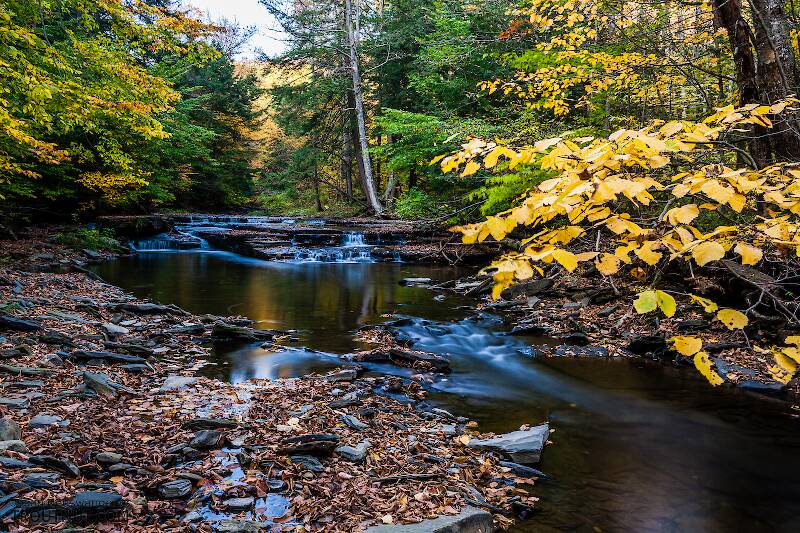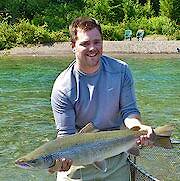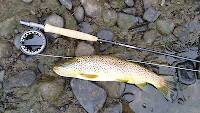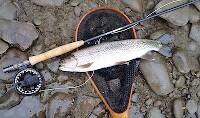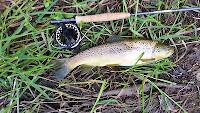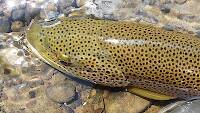
Salmonflies
Pteronarcys californica
The giant Salmonflies of the Western mountains are legendary for their proclivity to elicit consistent dry-fly action and ferocious strikes.
Featured on the forum

With a bit of help from the microscope, this specimen keys clearly and unsurprisingly to Hydropsyche.

Troutnut is a project started in 2003 by salmonid ecologist Jason "Troutnut" Neuswanger to help anglers and
fly tyers unabashedly embrace the entomological side of the sport. Learn more about Troutnut or
support the project for an enhanced experience here.
Troutnut on Sep 26, 2006September 26th, 2006, 7:13 am EDT
I like the direction this forum is heading, so I hate to risk steering it in the direction of so many other fly fishing communities (with endless dicussions of rods/lines). But I don't buy a new rod very often, so here goes.
I'm going to buy a new small-stream trout setup. Rods and casting are not my areas of expertise. I've never had a casting lesson in my life and a pro would laugh at my stroke, likely as not. But I'm pretty good at putting the fly right where I want it to be, and that is the important thing. The point is I don't really know what I'm doing so I'd like your comments on my current thoughts:
Cost: The lower the better. Certainly under $500.
Brand: Given the tight quarters of many small streams, a rod-breaking accident is more likely than I'd like. So I want something with an unconditional "no matter what" warranty. As far as I can tell, this limits me to Orvis, Scott, and Winston among the major manufacturers and eliminates Sage, Loomis, and St. Croix. Am I missing any?
Length: The shorter the better. It looks like 7'0" or 7'6" are my most likely options, though some are made at 6'0".
Action: The faster the better. Three reasons:
I know a lot of guys are into slow bambooish purism, and that's great, but I just want to keep my fly out of the alders.
Weight: I'm a bit unsure about this. Right now I'm leaning toward a 3-weight rod with a 4-weight line. I want to be able to control a small hopper or bugger, but I want something delicate enough not to frighten the trout in a tiny pool.
Line: Double taper floating. I'm used to double taper lines, so familiarity is a big factor, and they should settle more delicately on tiny pools.
Reel: I don't really know what my considerations should be here. I'll mostly be playing small trout on a short line, though I'll want to be able to handle a 15+ inch grayling next year in Alaska. I like a large arbor with a disc drag on my other rods, but I think for this one maybe a small, lightweight reel would be a good idea.
I'm puzzled by the fact that rods marketed as small-stream rods (like the Orvis Superfine and the Scott F-series) have slow actions. These, like 1- and 2-weight rods, seem better suited for delicate fishing over open water with tiny flies (like for spring creek Tricos). Does anyone want to play devil's advocate and explain why a slow action might be good on a small brushy stream? Am I missing something?
Specifics models: Here are the ones I'm looking at which come closest to my ideals above.
The 6'6" Scott A2 3-weight is looking best right now. Any thoughts?
I'm going to buy a new small-stream trout setup. Rods and casting are not my areas of expertise. I've never had a casting lesson in my life and a pro would laugh at my stroke, likely as not. But I'm pretty good at putting the fly right where I want it to be, and that is the important thing. The point is I don't really know what I'm doing so I'd like your comments on my current thoughts:
Cost: The lower the better. Certainly under $500.
Brand: Given the tight quarters of many small streams, a rod-breaking accident is more likely than I'd like. So I want something with an unconditional "no matter what" warranty. As far as I can tell, this limits me to Orvis, Scott, and Winston among the major manufacturers and eliminates Sage, Loomis, and St. Croix. Am I missing any?
Length: The shorter the better. It looks like 7'0" or 7'6" are my most likely options, though some are made at 6'0".
Action: The faster the better. Three reasons:
- I often need to throw a really tight loop through a narrow opening in the trees.
- I want the road to load well with a really short line.
- I do a lot of roll-casting.
- I've always used fairly fast rods, so they're familiar.
I know a lot of guys are into slow bambooish purism, and that's great, but I just want to keep my fly out of the alders.
Weight: I'm a bit unsure about this. Right now I'm leaning toward a 3-weight rod with a 4-weight line. I want to be able to control a small hopper or bugger, but I want something delicate enough not to frighten the trout in a tiny pool.
Line: Double taper floating. I'm used to double taper lines, so familiarity is a big factor, and they should settle more delicately on tiny pools.
Reel: I don't really know what my considerations should be here. I'll mostly be playing small trout on a short line, though I'll want to be able to handle a 15+ inch grayling next year in Alaska. I like a large arbor with a disc drag on my other rods, but I think for this one maybe a small, lightweight reel would be a good idea.
I'm puzzled by the fact that rods marketed as small-stream rods (like the Orvis Superfine and the Scott F-series) have slow actions. These, like 1- and 2-weight rods, seem better suited for delicate fishing over open water with tiny flies (like for spring creek Tricos). Does anyone want to play devil's advocate and explain why a slow action might be good on a small brushy stream? Am I missing something?
Specifics models: Here are the ones I'm looking at which come closest to my ideals above.
- Orvis TLS Power Matrix 705-5: 7’0” 4-weight (mid 6.0 flex = medium action?)
- Scott E2 is a 7’6” 3-weight (fast action)
- Scott A2 has a 6’6” or 7’10” 3-weight (medium fast action)
- Winston Vapor 7’6” 3-weight (fast action)
- The one fly shop near Ithaca stocks Heritage fly rods, which I had never heard of, but they make a 7'0" 3-weight (of unknown action). They sound OK and they're much cheaper than most. Has anyone used these?
The 6'6" Scott A2 3-weight is looking best right now. Any thoughts?
Jason Neuswanger, Ph.D.
Troutnut and salmonid ecologist
Troutnut and salmonid ecologist
JAD on Sep 26, 2006September 26th, 2006, 12:42 pm EDT
Hi Jason
Check out LL Bean on their guarantee, pretty good. As far as reels ,Old saying -- Reel holds line put your money in line & rod.
Regards
JAD
They fasten red (crimson red) wool around a hook, and fix onto the wool two feathers which grow under a cock’s wattles, and which in colour are like wax.
Radcliffe's Fishing from the Earliest Times,
Willy on Sep 26, 2006September 26th, 2006, 4:06 pm EDT
7'9 5 wt Orvis 5 Superfine... the Far and Fine. I believe it has just been discontinued, might be hard to find but well worth it. You usually think of a 5 wt as being overgunned for small stream fishing, but this rod is perfect.
If not, the whole Superfine series is great.
I have a 7'6 Loomis 4 wt that I don't know the name of. It came with a plastic reel and I won the outfit at a TU raffle. Anyways, it's also an awesome rod. Can cast a whole 5 wt line with it even. I think it's the entry level job, I can check for you if you want. Although you seem to have ruled them otu.
If not, the whole Superfine series is great.
I have a 7'6 Loomis 4 wt that I don't know the name of. It came with a plastic reel and I won the outfit at a TU raffle. Anyways, it's also an awesome rod. Can cast a whole 5 wt line with it even. I think it's the entry level job, I can check for you if you want. Although you seem to have ruled them otu.
Check out my fishing pictures on Instagram.
Softhackle on Sep 27, 2006September 27th, 2006, 1:11 am EDT
Jason,
I may get knocked for this, but Temple Fork has some very nice rods, and for the buck, they can't be beat. Also, no matter how you break one of their rods-your fault, their fault, the rod gets totally replaced. I know a lot of people look down on them, but I also know some fishermen, personally, that love them. Give them a serious look.
Their web site is: http://www.templeforkflyrods.com/rods/
I also have a son-in-law that broke the tip of his Temple Fork 2 piece rod. A new rod replaced it in no time. They have a very nice two piece 6 foot in 2 wt, and a 7' 6' in 3 wt for $99. Look in their "Signature series".
Mark
I may get knocked for this, but Temple Fork has some very nice rods, and for the buck, they can't be beat. Also, no matter how you break one of their rods-your fault, their fault, the rod gets totally replaced. I know a lot of people look down on them, but I also know some fishermen, personally, that love them. Give them a serious look.
Their web site is: http://www.templeforkflyrods.com/rods/
I also have a son-in-law that broke the tip of his Temple Fork 2 piece rod. A new rod replaced it in no time. They have a very nice two piece 6 foot in 2 wt, and a 7' 6' in 3 wt for $99. Look in their "Signature series".
Mark
"I have the highest respect for the skilled wet-fly fisherman, as he has mastered an art of very great difficulty." Edward R. Hewitt
Flymphs, Soft-hackles and Spiders: http://www.troutnut.com/libstudio/FS&S/index.html
Flymphs, Soft-hackles and Spiders: http://www.troutnut.com/libstudio/FS&S/index.html
Willy on Sep 27, 2006September 27th, 2006, 5:24 pm EDT
Honestly, I have never liked a Temple Fork I've cast. I don't remember the specs of the rods I've cast, but I've probably cast 3 of them and never liked the action. That's just me, a lot of people love 'em. What it really comes down to is you gotta cast a rod before you buy it.
Check out my fishing pictures on Instagram.
The_Sib on Oct 6, 2006October 6th, 2006, 6:46 am EDT
I think ( in my experience )that full flex rods can more easily load with only a few feet of line out past the tip.
They can achieve a greater degree of presentation delicacy ( generally speaking )than fast rods.
You can throw a tight enough loop with a full flex, it's all in your skill - it's not the rod - that achieves a tight loop. Full flex seems to be more forgiving of casting mistakes than fast rods.
Full flex can handle a big enough fish ( it's more a function of tippet size here but too long to go into ), AND smaller fish "feel" bigger, IMO - a better "sporting experience"
Full flex rods can REALLY roll cast ( much easier & better IMO ).
I just got one of the last Orvis 5 wt 7'9" Far and Fines - a
Orvis 5.5 full flex - and I think it is a superb fishing tool.
I use a Lamson Litespped 2 ( series 1 ) reel spooled with SA Trout WF5F camo line.
I have a TFO professional 4 piece 3 wt 7'6" - I like it for small streams. It's a medium-fast rod. I use a Sage 3200 click & pawl reel spooled with WF3F floating Rio Selective Trout in camo on this one.
Now, even though I like the TFO, I wish that I had cast a 3wt superfine first ( I cast about 8 or 9 different 3 wts but not the superfine ).
In my arsenal, I also have:
An Orvis Silver Label ( 6.0 flex that I consider a slow medium )
4 wt 7'11" 2 piece that is one of my NJ & PA "go to rods".
I use a 4 wt Orvis Wonderline on it with an Orvis Battenkill 3/4 reel.
A 40 year old Garcia-Conolon fiberglass 5 wt 8' 2 piece which is REALLY slow - but powerful and delicate. My other "go to".
( The Far and Fine will probably replace this most times now )
I use an Orvis Rocky Mountain LA 5/6 with WF5F Orvis wonderline.
A 9' 5 wt 4 piece Sage XP - my "big water / windy condition" fast cannon. I really like it too but most waters I fish in NJ & PA are on the small side with a lot of cover, so I like a little shorter rod
( 7-ish to 8' ) most of the time. I use a Lamson Litespeed 2 with Rio Grand light green WF5F line.
I think a 6'-ish rod is more of a specialty rod BUT it may serve your fishing conditions....
They can achieve a greater degree of presentation delicacy ( generally speaking )than fast rods.
You can throw a tight enough loop with a full flex, it's all in your skill - it's not the rod - that achieves a tight loop. Full flex seems to be more forgiving of casting mistakes than fast rods.
Full flex can handle a big enough fish ( it's more a function of tippet size here but too long to go into ), AND smaller fish "feel" bigger, IMO - a better "sporting experience"
Full flex rods can REALLY roll cast ( much easier & better IMO ).
I just got one of the last Orvis 5 wt 7'9" Far and Fines - a
Orvis 5.5 full flex - and I think it is a superb fishing tool.
I use a Lamson Litespped 2 ( series 1 ) reel spooled with SA Trout WF5F camo line.
I have a TFO professional 4 piece 3 wt 7'6" - I like it for small streams. It's a medium-fast rod. I use a Sage 3200 click & pawl reel spooled with WF3F floating Rio Selective Trout in camo on this one.
Now, even though I like the TFO, I wish that I had cast a 3wt superfine first ( I cast about 8 or 9 different 3 wts but not the superfine ).
In my arsenal, I also have:
An Orvis Silver Label ( 6.0 flex that I consider a slow medium )
4 wt 7'11" 2 piece that is one of my NJ & PA "go to rods".
I use a 4 wt Orvis Wonderline on it with an Orvis Battenkill 3/4 reel.
A 40 year old Garcia-Conolon fiberglass 5 wt 8' 2 piece which is REALLY slow - but powerful and delicate. My other "go to".
( The Far and Fine will probably replace this most times now )
I use an Orvis Rocky Mountain LA 5/6 with WF5F Orvis wonderline.
A 9' 5 wt 4 piece Sage XP - my "big water / windy condition" fast cannon. I really like it too but most waters I fish in NJ & PA are on the small side with a lot of cover, so I like a little shorter rod
( 7-ish to 8' ) most of the time. I use a Lamson Litespeed 2 with Rio Grand light green WF5F line.
I think a 6'-ish rod is more of a specialty rod BUT it may serve your fishing conditions....
Sib
GONZO on Oct 6, 2006October 6th, 2006, 8:46 am EDT
I suspect that Jason has already made his choice--one can only tolerate fishing small streams with a 7-weight for so long! However, since The Sib has dared to play "devil's advocate" by speaking in favor of slower small rods, I'll add my opinion. I agree.
In Southcentral PA, the short rod is as sacred as spring creeks and sulphurs, especially among the old hands like Ed Shenk and Ed Koch. I have fished with short (sub-7') rods for more than 40 years. Yes, I have longer (and faster) rods, but nothing is as delightful as fishing a 5 1/2'-6 1/2' medium-slow action rod on small streams and tribs.
Clearly we've been living in a fast-taper, long-rod age; but if that's all that's in your arsenal, I hope you're fishing long casts on big waters. Otherwise, you might be a victim of technological hype.
I agree with Sib that slower rods load easier with less line and that short rods are not an impediment to landing fairly large fish. I have landed plenty of 20-25" trout on short rods without having to "worry" them to death. (Lee Wulff, another short rod advocate, considered shorter rods to be more efficient fish-fighting tools than longer rods.)
Jason indicated that he was considering using a heavier-than-recommended line weight on his new rod. This would effectively slow the rod and improve short distance loading. That would be wise with a faster rod, but it can also improve the close-in performance of some slower rods.
I also agree that a slower rod is more forgiving, but shorter rods are not! A shorter rod has a much quicker casting tempo, which takes some getting used to if you've only fished 8' and up. A slower short rod makes the adjustment a little easier, but the casting tempo is still quick.
A short rod is also capable of throwing a decent length of line. In the hands of a good caster with an effective double-haul, casts of 50-60' are quite attainable. Unless you are swinging wet flies or streamers on a tight line, however, it's a pretty stupid thing to try--the only significant drawbacks to short rods are their mending and hook-setting abilities over distance. There is nothing more disappointing and counterproductive than to lay out a sweet 45' cast to a nice riser, have it take, and then realize that there is no way to get the slack out of the line quick enough to set the hook! A faster short rod might have a very slight edge in this regard, but unless you strike like a Bassmaster, the difference is pretty much moot.
Of the rods you were considering, Jason, I'm hoping you opted for the 6 1/2' Scott (though I would prefer the action of the V2). You'll have no trouble with big Alaskan grayling unless you try to fish halfway across a big river. I'm also hoping you didn't pair it with one of those heavy large-arbor reels (they're fine for big rods). A nice Hardy Flyweight would be perfect, but the smallest Orvis Battenkill Bar Stock is probably a better buy (the disc drag is wasted weight in this application, but it's a fine reel for the money).
In Southcentral PA, the short rod is as sacred as spring creeks and sulphurs, especially among the old hands like Ed Shenk and Ed Koch. I have fished with short (sub-7') rods for more than 40 years. Yes, I have longer (and faster) rods, but nothing is as delightful as fishing a 5 1/2'-6 1/2' medium-slow action rod on small streams and tribs.
Clearly we've been living in a fast-taper, long-rod age; but if that's all that's in your arsenal, I hope you're fishing long casts on big waters. Otherwise, you might be a victim of technological hype.
I agree with Sib that slower rods load easier with less line and that short rods are not an impediment to landing fairly large fish. I have landed plenty of 20-25" trout on short rods without having to "worry" them to death. (Lee Wulff, another short rod advocate, considered shorter rods to be more efficient fish-fighting tools than longer rods.)
Jason indicated that he was considering using a heavier-than-recommended line weight on his new rod. This would effectively slow the rod and improve short distance loading. That would be wise with a faster rod, but it can also improve the close-in performance of some slower rods.
I also agree that a slower rod is more forgiving, but shorter rods are not! A shorter rod has a much quicker casting tempo, which takes some getting used to if you've only fished 8' and up. A slower short rod makes the adjustment a little easier, but the casting tempo is still quick.
A short rod is also capable of throwing a decent length of line. In the hands of a good caster with an effective double-haul, casts of 50-60' are quite attainable. Unless you are swinging wet flies or streamers on a tight line, however, it's a pretty stupid thing to try--the only significant drawbacks to short rods are their mending and hook-setting abilities over distance. There is nothing more disappointing and counterproductive than to lay out a sweet 45' cast to a nice riser, have it take, and then realize that there is no way to get the slack out of the line quick enough to set the hook! A faster short rod might have a very slight edge in this regard, but unless you strike like a Bassmaster, the difference is pretty much moot.
Of the rods you were considering, Jason, I'm hoping you opted for the 6 1/2' Scott (though I would prefer the action of the V2). You'll have no trouble with big Alaskan grayling unless you try to fish halfway across a big river. I'm also hoping you didn't pair it with one of those heavy large-arbor reels (they're fine for big rods). A nice Hardy Flyweight would be perfect, but the smallest Orvis Battenkill Bar Stock is probably a better buy (the disc drag is wasted weight in this application, but it's a fine reel for the money).
Softhackle on Oct 7, 2006October 7th, 2006, 5:47 am EDT
Hi All,
I do not disagree with using shorter rods for smaller streams. I would say fish the longest rod you dare for the place you are fishing. In my opinion and experience the long rod always allows more line control because less line is on/in the water. This equals less drag and quicker strikes. It helps the angler reach out, as well. Nowadays, light, long rods offers the angler finer specs for fishing.
Mark
I do not disagree with using shorter rods for smaller streams. I would say fish the longest rod you dare for the place you are fishing. In my opinion and experience the long rod always allows more line control because less line is on/in the water. This equals less drag and quicker strikes. It helps the angler reach out, as well. Nowadays, light, long rods offers the angler finer specs for fishing.
Mark
"I have the highest respect for the skilled wet-fly fisherman, as he has mastered an art of very great difficulty." Edward R. Hewitt
Flymphs, Soft-hackles and Spiders: http://www.troutnut.com/libstudio/FS&S/index.html
Flymphs, Soft-hackles and Spiders: http://www.troutnut.com/libstudio/FS&S/index.html
Troutnut on Oct 8, 2006October 8th, 2006, 6:51 am EDT
Thanks everyone for the advice.
After feeling several in the shop (Beaverkill Angler) and casting the one I got and a nice little Scott, I ended up going with a 7' 4-weight 4-piece Orvis Superfine (full flex -- 3.0 on their scale) with a small Battenkill bar stock and DT4F wonderline.
I really like the feel of it, and I've already caught on to casts under 30 feet really well. I like that little brookies put a bend in it, too. At 30 feet and out, I've made some really nice casts when I get my timing just right, but I still need lots of practice... about 3 out of 4 come out looking a bit sloppy. Clearly the rod can handle it once I get a better feel for it.
Going out get more of that practice now. :)
After feeling several in the shop (Beaverkill Angler) and casting the one I got and a nice little Scott, I ended up going with a 7' 4-weight 4-piece Orvis Superfine (full flex -- 3.0 on their scale) with a small Battenkill bar stock and DT4F wonderline.
I really like the feel of it, and I've already caught on to casts under 30 feet really well. I like that little brookies put a bend in it, too. At 30 feet and out, I've made some really nice casts when I get my timing just right, but I still need lots of practice... about 3 out of 4 come out looking a bit sloppy. Clearly the rod can handle it once I get a better feel for it.
Going out get more of that practice now. :)
Jason Neuswanger, Ph.D.
Troutnut and salmonid ecologist
Troutnut and salmonid ecologist
Quick Reply
Related Discussions
Topic
Replies
Last Reply
3
Jan 11, 2012
by Strmanglr
by Strmanglr

